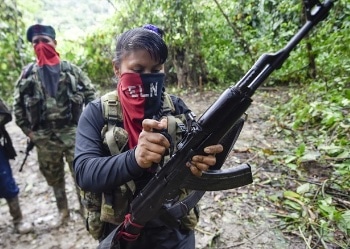A new study has revealed how Colombia’s armed groups have changed tactics around child recruitment.
The study, jointly carried out by UNICEF and the Colombian Institute of Family Welfare (Instituto Colombiano de Bienestar Familiar – ICBF), examined the experiences of 2,181 minors registered with the ICBF between 2013 and 2022. It provides insights into the strategies used by organized crime groups to recruit minors, as well as the profiles of minors the groups sought out during this period.
Below, InSight Crime examines the report’s most important findings.
Colombia’s Changing Panorama
The power dynamics among Colombia’s armed groups have shifted dramatically in the last decade, following the disarmament of the Revolutionary Armed Force of Colombia (Fuerzas Armadas Revolucionarias de Colombia – FARC) in 2016. Since then, the National Liberation Army (Ejército de Liberación Nacional – ELN) has become the leading recruiter of minors, with 406 cases, the report found.
SEE ALSO: How Colombia’s Lockdown Created Ideal Conditions for Child Recruitment
The ex-FARC mafia, a group of loosely connected criminal factions who refused to lay down arms following the FARC’s disarmament, was second with 118, while the Gaitanist Self-Defense Forces of Colombia (Autodefensas Gaitanistas de Colombia – AGC), also known as the Urabeños, was third with 68 cases of recruitment of minors.
The Venezuelan migration crisis and the movement of the ELN and ex-FARC mafia groups into Venezuela have also contributed to the use of recruitment of minors. Incidents of recruitment involving Venezuelan minors jumped from seven between 2007 and 2013, to 39 between 2013 and 2022, a 457% increase. At least 15 minors were recruited on Venezuelan soil.
The report also noted how the COVID-19 pandemic put more youths at risk. This was especially the case in rural areas, where armed groups took advantage of the closure of schools and the increase in minors permanently leaving formal education. Between 2020 and 2022, 532 minors were recruited across 27 departments.
At-Risk Youth
The investigation showed that the ethnic and family backgrounds of minors heavily influenced how likely it was that minors would be targeted for recruitment by criminal organizations.
“The study’s most important finding is that recruited children were living in conditions where their rights were being violated, which is a determining factor in their recruitment,” Olga Lucía Zuluaga, UNICEF Colombia protection officer, told InSight Crime.
According to the study, 78% of minors recruited said they experienced violence within their families before joining. Additionally, 56% of the children surveyed said that at least one member of their family belonged to an armed group, especially among the Afro-Colombian community.
On average, the majority of recruited minors were between 13 and 14 years old. In addition, 69% lived in rural areas and were from low-income families, while 89% lived in regions where armed conflict was prevalent.
The Nariño, Antioquia, Chocó, Cauca, Caquetá, Arauca and Putumayo departments, which have a strong presence of organized crime groups and which are used for the production and movement of drugs, led statistics for youth recruitment.
The report found that 80% of the children performed paid or unpaid labor for organized armed groups, including cultivating illicit crops, delivering packages, or reporting on community movements, prior to being formally recruited. The majority of the children said they did this voluntarily. They carried on these jobs once recruited.
The percentage of girls and young women recruits grew by 4% to 34%, while the recruitment of Indigenous or Afro-Colombian minors grew to 37% in comparison to 27% in the previous report.
Ethnic populations are more exposed to criminal actors because these populations tend to live in departments where criminal groups produce and transit drugs, Zuluaga explained. Girls, for their part, are exposed to gender-based violence before and after being recruited. “They continue to be used and sexually exploited,” Zuluaga said.
New Recruitment Tactics
Deception continues to be a common recruitment tactic, but groups are also recruiting through social events and social media. While criminal groups continue to rely on tried and true recruitment tools, they have begun using new means to reach their targets.
Armed groups use social media networks to present a romanticized vision of members’ lives. “[Armed group members] are in boats carrying cocaine, in uniform, showing the good life,” said Zuluaga, adding that groups also host parties, involving themselves in adolescent spaces.
In urban areas, drugs are used to entice, particularly by gangs dedicated to microtrafficking. Groups provide drugs to minors to lure them into addiction before forcing them to join the group, Zuluaga explained.

